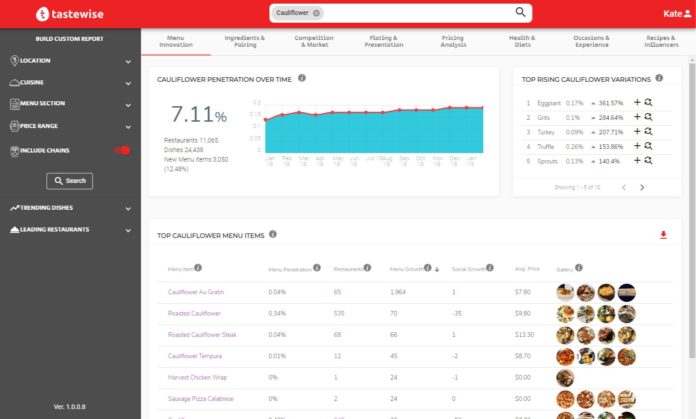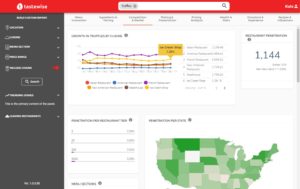
With social media reinventing trend evolution, food manufacturers and restaurants are struggling to keep up with their customers. Today’s consumers are adventurous tasters and health-conscious dieters, quickly shifting from one craze to the next. What if companies could respond immediately to culinary trends?
New startup Tastewise has an artificial intelligence (AI) solution that could revolutionize the way food companies do business by mining online data, including social media, to find the fastest-growing food trends. For example, Tastewise says the industry is currently missing out on “$9 billion dollars in untapped demand for healthy food,” because restaurants and food companies are unaware of what their customers are craving and what market opportunities are available.
We spoke with Tastewise co-founder and CEO Alon Chen to learn how the platform employs machine learning to create a food forecast.
It began over dinner
Chen, a former Google executive, found inspiration for Tastewise from his family’s WhatsApp group. Before inviting the family for dinner on Fridays, his mother habitually asked everyone if they had any new dietary requirements. “It’s actually very interesting that most of us had something new that we were eating or not eating that week. Including yours truly.”
He realized this wasn’t just a common discussion within his family circle. So, he reached out to food manufacturers and restaurants, who shared their struggles to please their customers in a world where food fads and diet plans are ever-evolving. “It used to be pretty stagnant and not changing so fast,” Chen says. “But today the, what I call, culinary consciousness of all of us, of everybody basically, is really impacting the industry as a whole.”
How does the platform work?
“Tastewise goes through the web and looks at more than 150,000 menus,” Chen explains. “We’re trying to see what’s new on the menu, and at the same time we’re looking at the social conversation to see what gets people excited.” This analysis includes over 1 billion food photos shared every month on apps like Instagram.
When comparing the social data on specific diets or ingredients to the foods and dishes currently available, the folks behind Tastewise uncovered significant gaps. They were even able to pinpoint specific unmet opportunities by city and state. For example, they found a 246% gap in demand for vegan food in Boston, translating to $41.9 million.
What’s trending now?
To start filling in that void, Chen shared a few current cravings companies should explore.
One hot new food is a healthy alternative to Sriracha. It’s called zhug, and Chen says it’s up 129% on social media and 3.5% on menus. Zhug is simple to make at home with hot peppers, parsley, coriander, and cumin seed. And it doesn’t contain the processed sugars found in Sriracha. Because of this, it works quite well as part of a clean-eating diet.
 Ube, a purple Filipino yam, is also winning over consumers. Food curators are using it to color their dishes in a stunning violet hue. It has a sweet, nutty vanilla flavor that blends nicely with desserts like gelato, ice cream, and cheesecake. With all the concerns surrounding artificial dyes, it’s a welcoming sight to see natural ingredients painting our plates.
Ube, a purple Filipino yam, is also winning over consumers. Food curators are using it to color their dishes in a stunning violet hue. It has a sweet, nutty vanilla flavor that blends nicely with desserts like gelato, ice cream, and cheesecake. With all the concerns surrounding artificial dyes, it’s a welcoming sight to see natural ingredients painting our plates.
 Next up, Tastewise’s recipe analysis revealed that some classic American favorites are taking on more truffles. The truffle, a funky-smelling type of fungus with a rough, misshapen appearance, doesn’t sound appetizing by description. Due to their seasonal nature, specific growth requirements, and the difficulty in hunting them down (usually a task for trained dogs or pigs), truffles are quite expensive, too. However, consumers are attracted to the unique taste and potential antibacterial, cancer-fighting health benefits of this delicacy. Chen says “fries now have truffles — truffle oil, or real truffles — being sprinkled on them.” It gives the beloved french fry a “more exclusive, more lucrative, and more Italian flavor.”
Next up, Tastewise’s recipe analysis revealed that some classic American favorites are taking on more truffles. The truffle, a funky-smelling type of fungus with a rough, misshapen appearance, doesn’t sound appetizing by description. Due to their seasonal nature, specific growth requirements, and the difficulty in hunting them down (usually a task for trained dogs or pigs), truffles are quite expensive, too. However, consumers are attracted to the unique taste and potential antibacterial, cancer-fighting health benefits of this delicacy. Chen says “fries now have truffles — truffle oil, or real truffles — being sprinkled on them.” It gives the beloved french fry a “more exclusive, more lucrative, and more Italian flavor.”
Consumers are seeking out creative pizza ingredients as well. Surprisingly, broccoli is on the rise, as is Nutella. Yes, you read that right: Nutella. It’s featured on dessert pizzas in the New York area, which Chen says are wildly popular.
Beyond specific ingredients, Tastewise also tracks rising health and dietary preferences, including the desire for foods that are organic, vegetarian, keto, clean, hand-crafted, and designed to enhance fitness.
Helping food companies understand their consumers
So, how can food manufacturers use this data, given that it takes quite a bit longer for a food company to modify its ingredients than it does for a restaurant to switch up its menu?
“If you’re a food brand,” Chen says, “you will be looking for trends that are more permanent and don’t fade out quickly.” Traditional surveys and focus groups can take several months to show results. By then, consumers may have already moved on to the next big thing. Because Tastewise is updated in real time, it speeds up the data collection process immensely.
Plus, if food companies know the current dietary demands of their customers, they can either create new products for them or better advertise products that already fulfill those needs. “Sometimes, they don’t even need to change the dish itself,” Chen adds. “They just need to make sure that people know that this dish is gluten-free because it happened to be already gluten-free. The dish is 100% made of plants, so why not write “vegan” on it?”
Tastewise is poised to be a critical partner in decision-making and strategic planning among food industry executives (for example, check out their insights into the meat alternatives market). Perhaps we’re approaching a world where consumers can communicate their food preferences to companies the same way they share them with family or friends before a meal.







